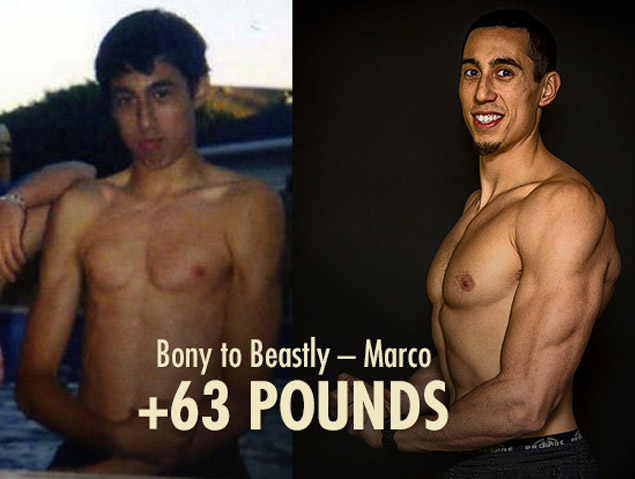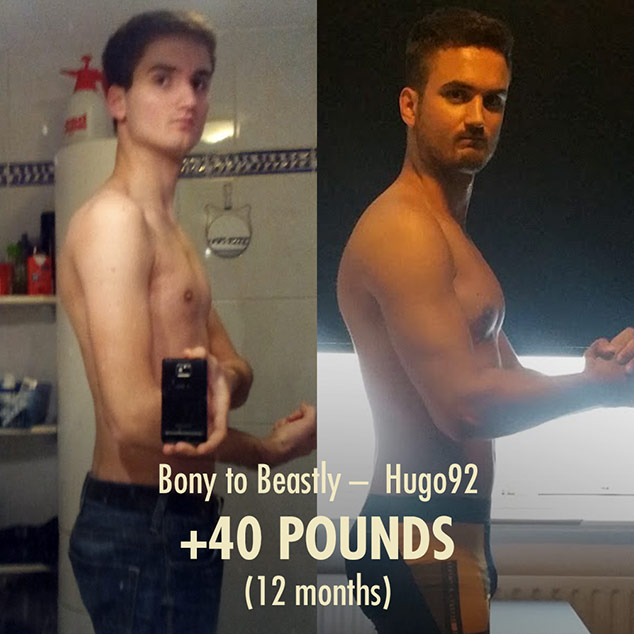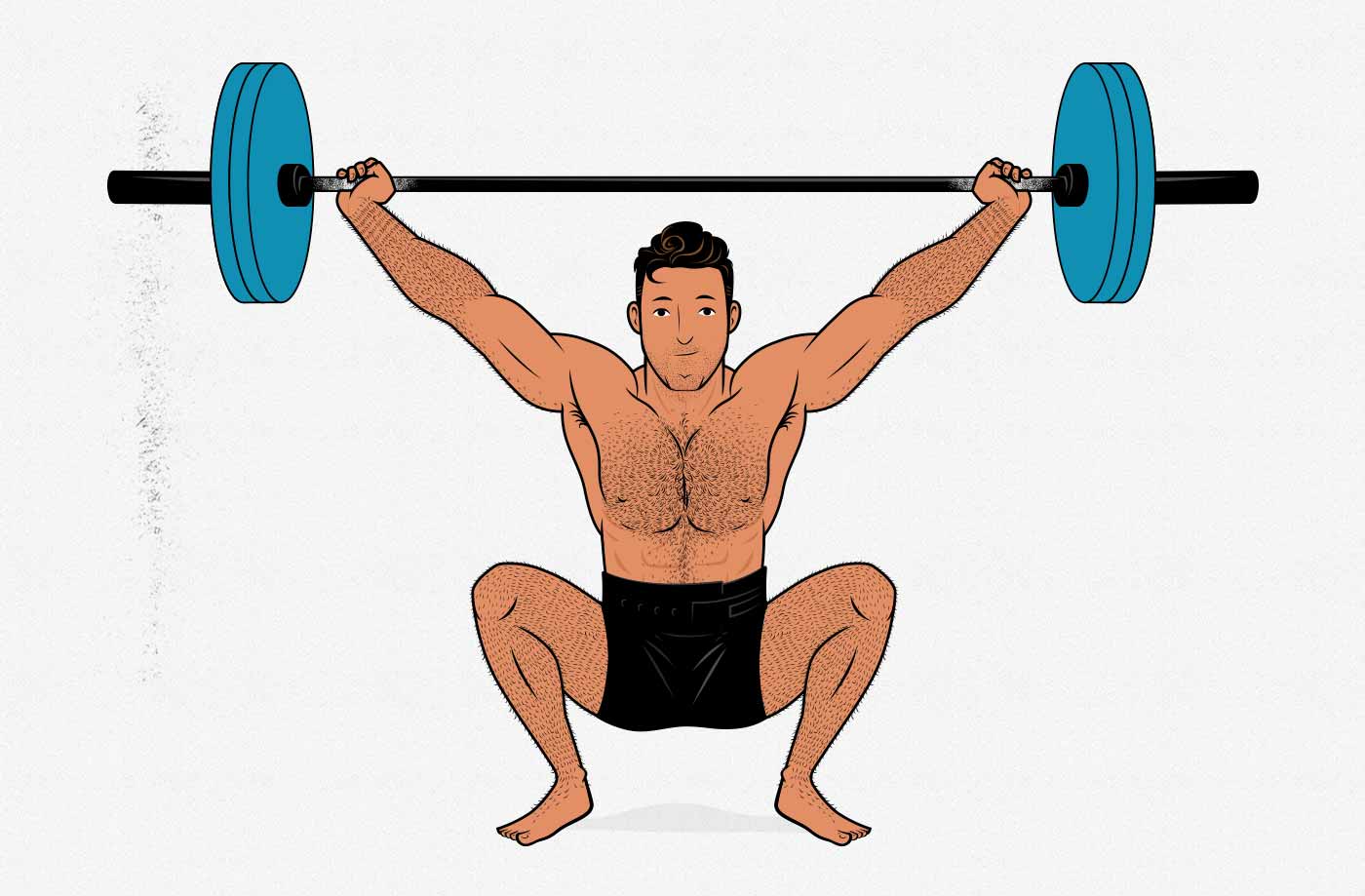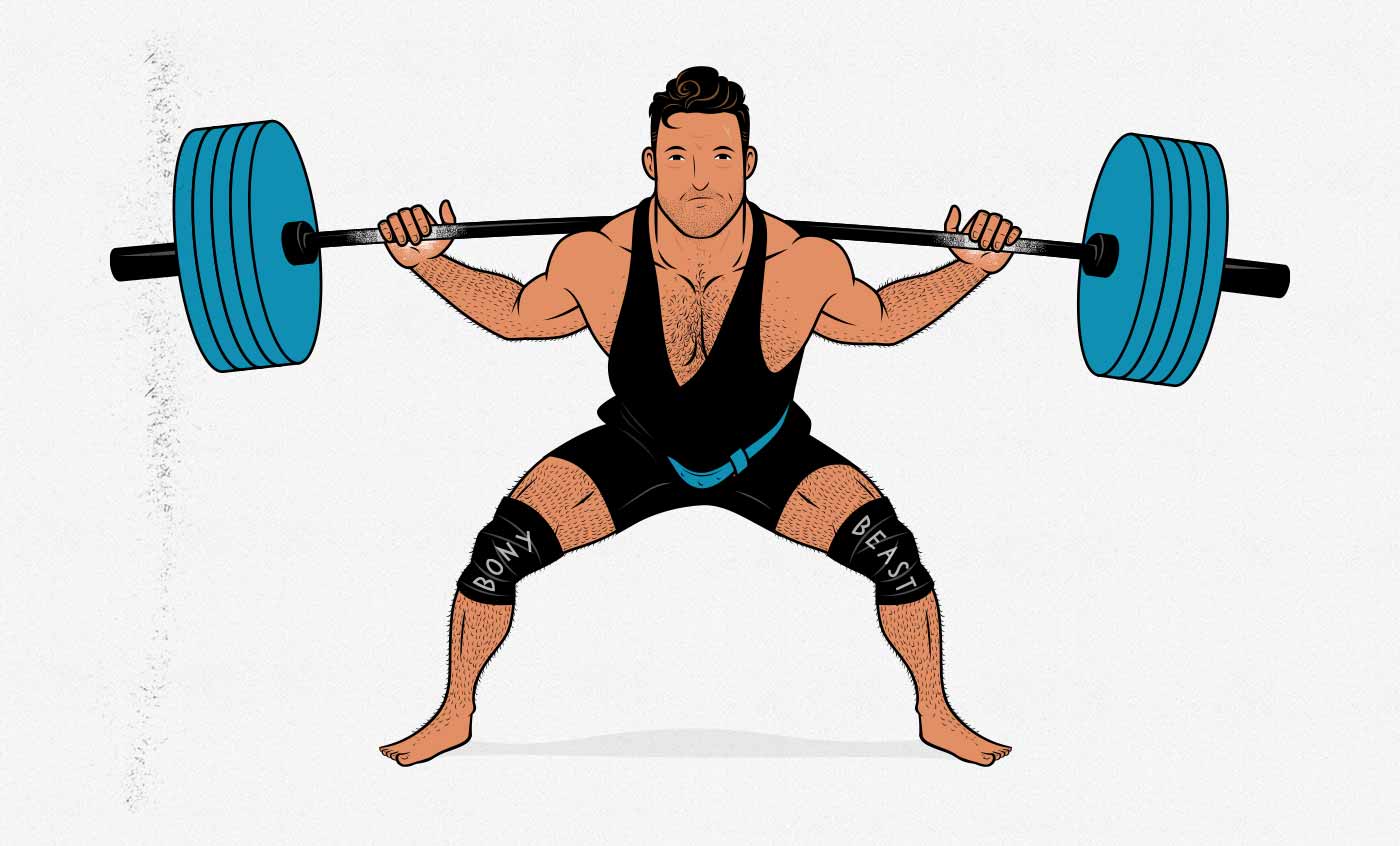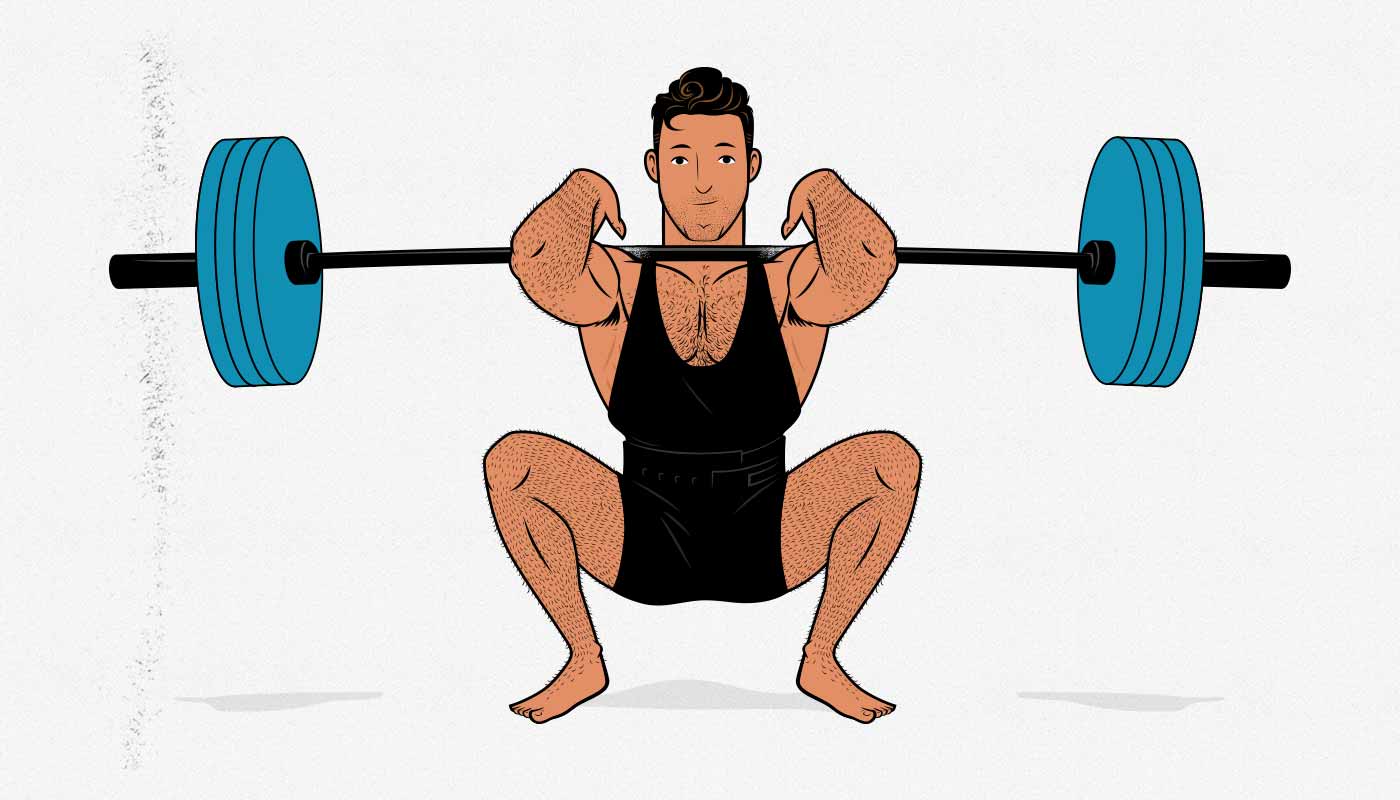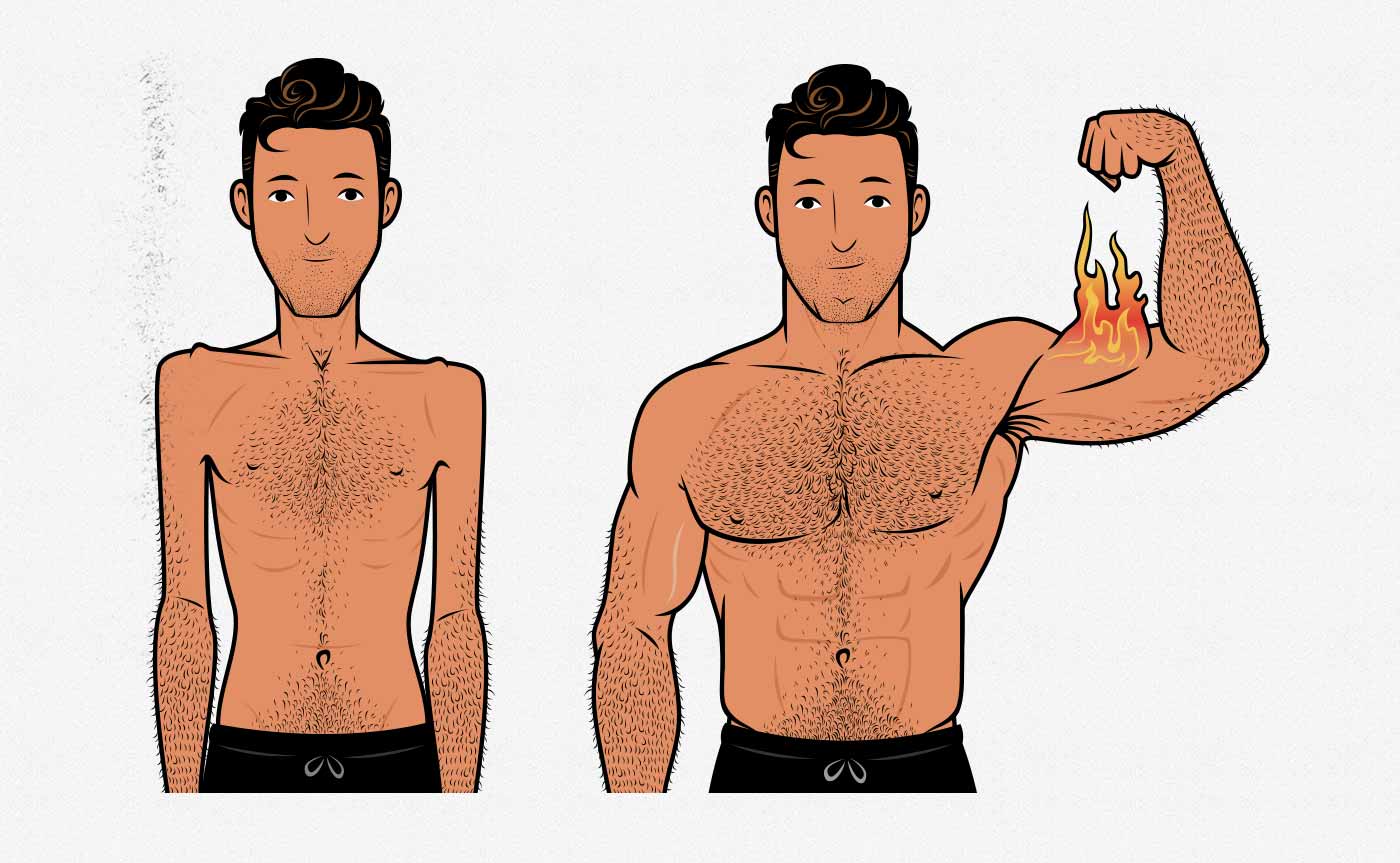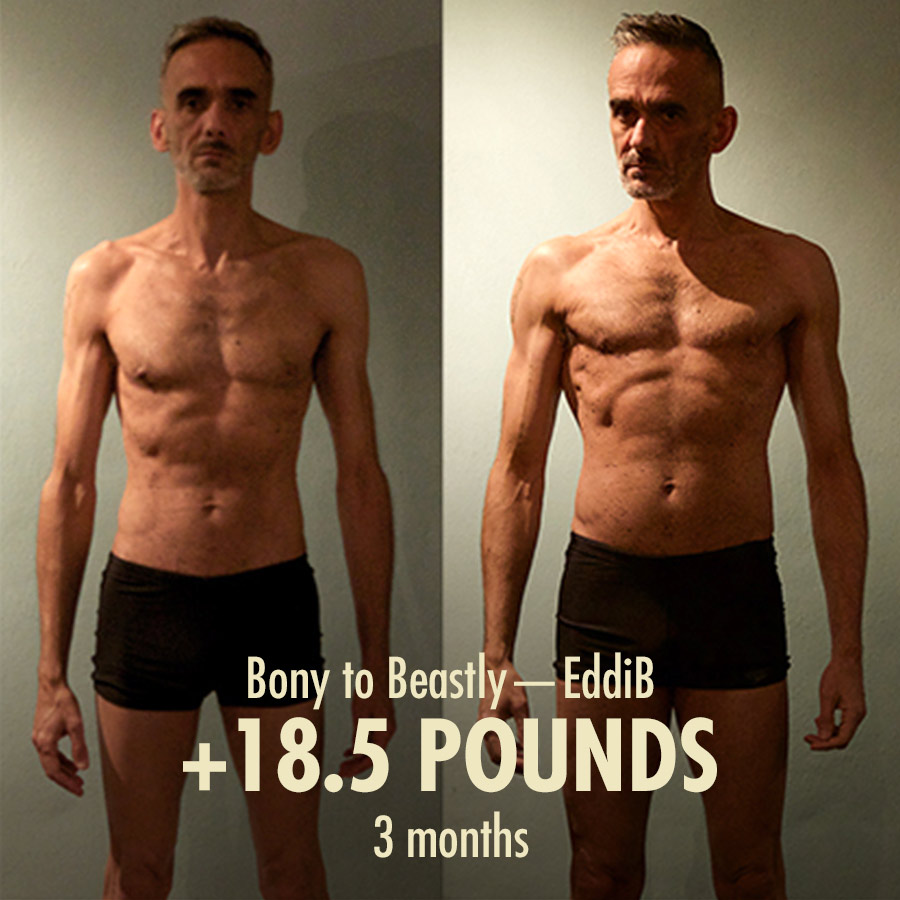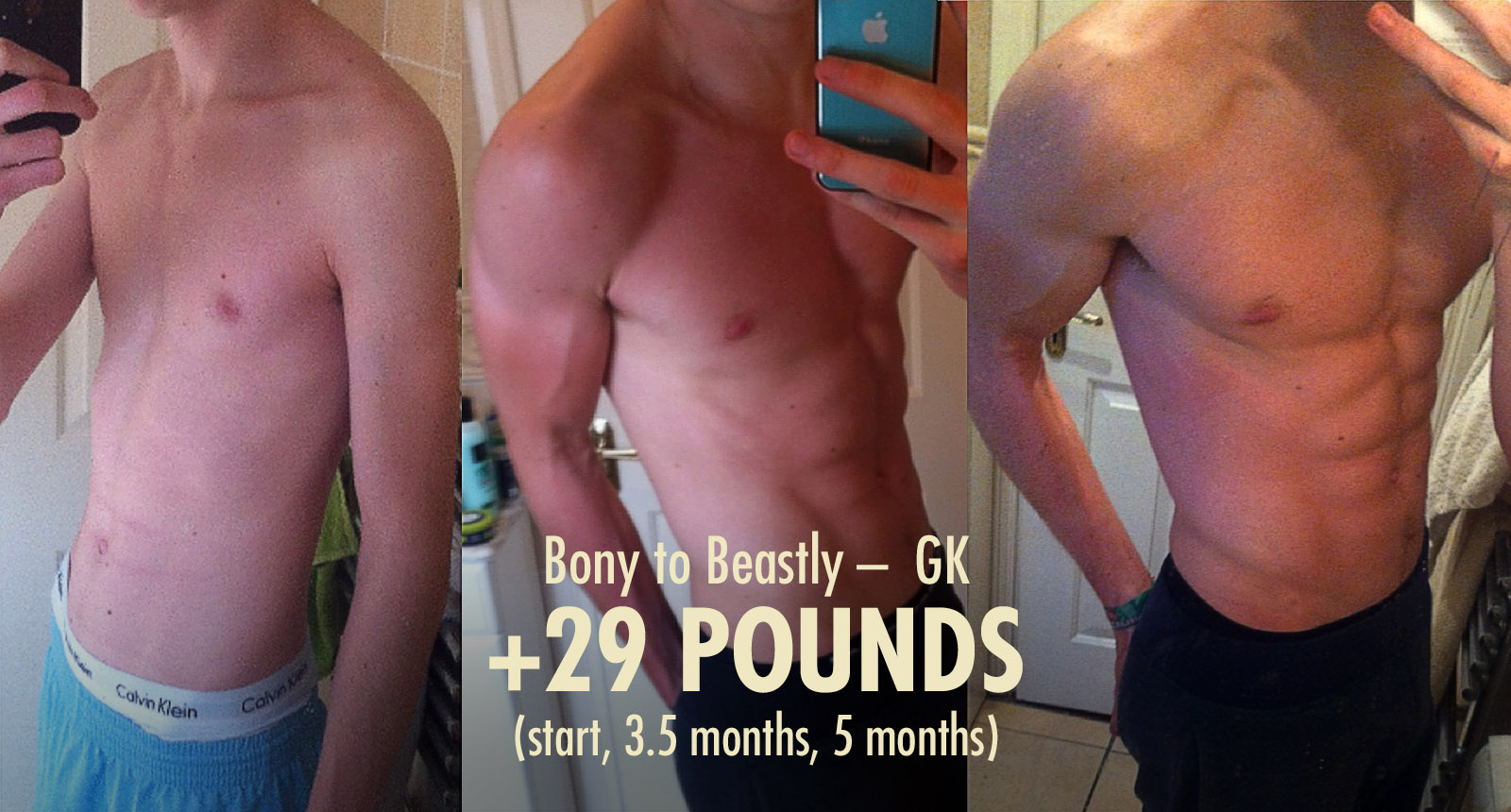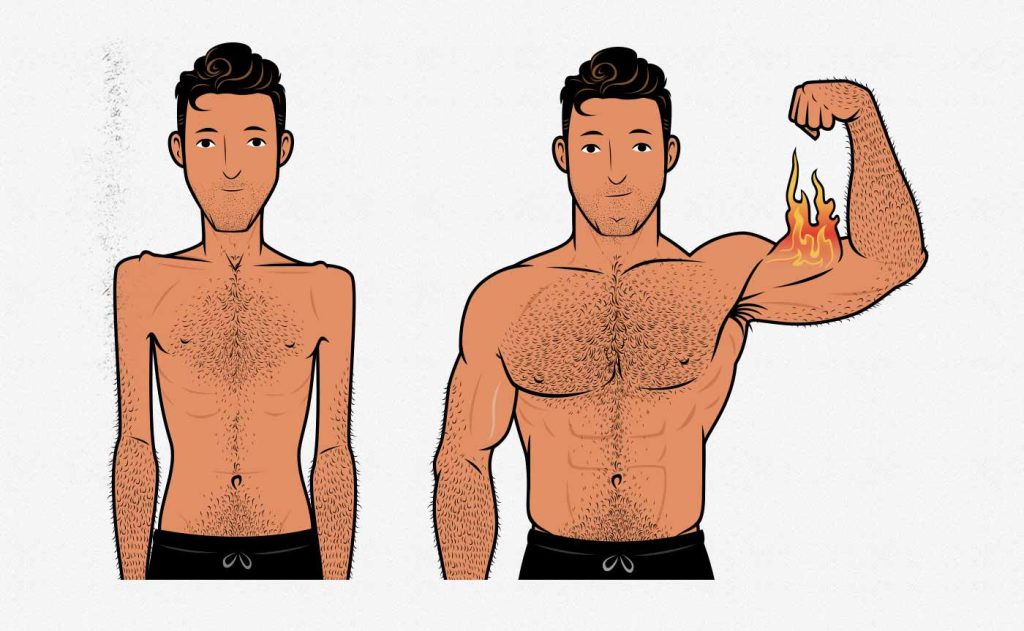
Why Can’t I Build Muscle?
Our specialty is helping naturally skinny hardgainers bulk up. One of the main questions we get is: why can’t I build muscle? We have skinny guys coming to us after years of trying and failing to build muscle. No matter what they try, their bodies don’t grow. It’s a rare issue. Most people are overweight. But it’s not rare here. This is what we do.
So, first of all, I’m a hardgainer myself. I grew up skinny, and I spent several years trying to build muscle without gaining a single pound. Even though I was exercising, lifting weights, and eating as much food as I could, my body refused to gain muscle. I gave up several times, assuming that my genetics would keep me skinny forever. Sometimes I was so frustrated that I would give up for months or even years at a time.
But I did eventually figure it out. I did eventually succeed at building muscle. Here’s a photo showing me at 130 pounds and then at 190 pounds, at around 11% body fat in both photos:
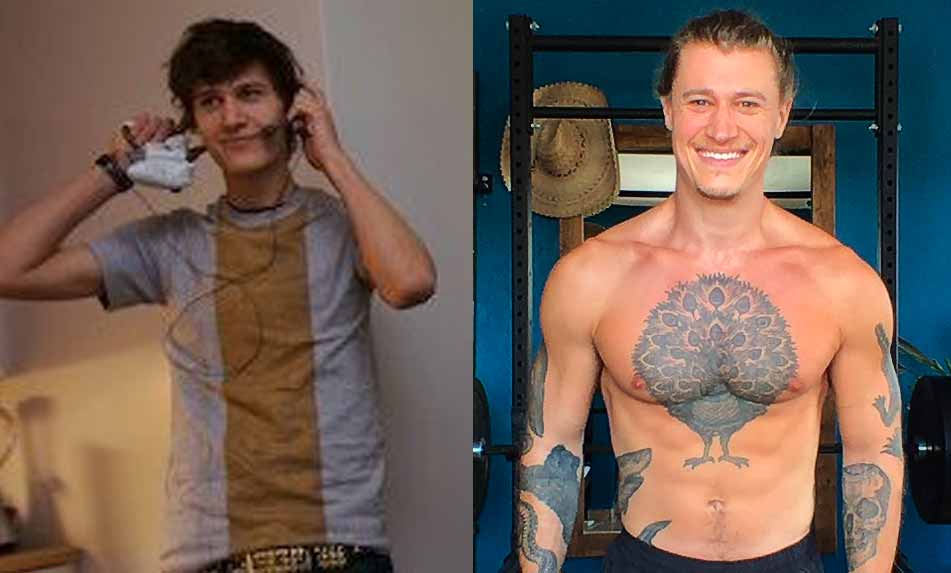
My transformation was completely natural—just weight training, eating a good bulking diet, and improving my lifestyle—and I was able to gain 55 pounds within just two years. So not only was I able to build muscle, but I was able to build it quite quickly. It’s kind of crazy remembering back to when I thought I had poor muscle-building genetics. I didn’t. I just wasn’t training and dieting in a way that suited my naturally skinny “hardgainer” body type.
I’m not an outlier, either. Before he started helping college, professional, and Olympic athletes bulk up, my business partner, Marco Walker-Ng, BHSch, PTS, PN, gained 63 pounds while getting his health sciences degree and his personal training certifications:
And we’ve reproduced these results in thousands of online clients over the years, such as Hugo, who gained forty pounds during a single year:
So then the question is, if our genetics aren’t limiting our muscle growth, what the Hell is going on? Why is it so incredibly hard for us to build muscle? Why is it that we spend years without making any gains and then all of a sudden explode into growth?
The first reason is the more obvious one. Hardgainers are good at building muscle, we’re just not very good at gaining weight. And if we aren’t gaining weight, there’s no surplus material to build muscle tissue with, and so we fail to gain any muscle. It’s only once we succeed at gaining weight that our muscle growth kicks into gear.
For instance, one study looking into muscle-building genetics found that skinny guys are able to build muscle more quickly than other body types. And that’s great, right? But the researchers knew that to gain muscle, we have to gain weight, so they disqualified all the participants who weren’t able to gain weight.
(Note that skinny-fat guys have a slightly different issue. We have a separate article for skinny-fat guys.)
Why Can’t We Gain Weight?
So what this study shows us that we can build muscle wonderfully well if we can succeed at gaining weight. But for hardgainers, gaining weight can be extremely difficult. We have a full article on why it’s so hard for hardgainers to gain weight, but here are a few reasons:
- Because our torsos are thinner, our stomachs are physically smaller.
- Because we have less fat to insulate us, more of our body heat radiates outwards, and our metabolisms rise higher.
- Being thin gives us a greater surface area relative to our weight, causing us to radiate even more heat outwards, and causing our metabolisms to rise even higher.
- Many of us are fidgety and/or put our bodies in inefficient positions, raising their metabolisms higher still.
- Because we’re more insulin sensitive, we feel full more easily, at which point it becomes extremely uncomfortable to continue eating.
- When we get stressed or busy, our appetite disappears and we often forget to eat.
So as you can see, our stomachs are smaller, our metabolisms are faster, and our appetites are less aggressive. This can make it very difficult to eat enough food to gain weight, which is made harder still because all of the popular diets were created for overweight people trying to lose weight.
For example, intermittent fasting is often advertised for helping people make lean gains. But the base assumption is that people are overeating. It’s a diet designed to help people eat less food. Not only does intermittent fasting make it harder to gain weight (study), but it’s also actually quite bad for building muscle.
Another example is low-carb and ketogenic diets, which have become popular diets to combine with weight training. Again, the whole point of limiting carbohydrates is to reduce our calorie intake, making it harder to gain weight. These are weight-loss diets. No wonder that if we try to use them to gain weight, we fail.
Why Don’t We Build Muscle When Working Out?
The other problem that hardgainers run into is that most workout programs aren’t designed to stimulate muscle growth.
Some types of exercise, such as cardio, obviously aren’t designed for building muscle. I went through phases of focusing on cardio because I was fed up with being the skinniest guy at the gym. At least with cardio, it’s something that I was naturally good at. I could tell that my lighter frame gave me an advantage over the typical overweight person. Cardio is quite good for our health, too. We build more blood vessels, improve our oxygen delivery, and develop a higher red blood cell count. Great things, but I knew it wouldn’t help me build muscle, and I knew that building muscle was even more crucial for my health. After all, I was clinically underweight. So I would eventually turn back to weight training. And that’s where things got confusing.
With weight training, I assumed that all of it was designed to stimulate muscle growth. But that’s not the case. The vast majority of people are overweight. In fact, according to one survey, only 3% of people are trying to gain weight. We’re a tiny minority. Even with weight training, most programs aren’t designed to help skinny people bulk up.
For instance, CrossFit is a type of exercise known as high-intensity power training (HIPT), which is quite similar to high-intensity interval training (HIIT), except that it promotes fitness adaptations by using explosive Olympic weightlifting instead of sprints. In my naivety, I didn’t realize that CrossFit was just another type of cardio—cardio done with weights.
Now, CrossFit can certainly stimulate some muscle growth as a byproduct, especially if you gain weight and muscle easily. But the time under tension is very low, the lifts aren’t great for stimulating muscle growth, there’s no system of steady progressive overload, and there’s a huge emphasis on power and momentum. CrossFit is not a good way to train for muscle growth.
So what about the opposite of CrossFit? What if instead of doing high-rep Olympic weightlifting, we choose low-rep strength training? That’s where things get really confusing. Strength training programs like Starting Strength and StrongLifts 5×5 often claim to be quite for building muscle, and that’s not entirely wrong. They’re quite a bit better for building muscle than cardio programs. But these programs aren’t designed for muscle growth either. Rather, the low rep ranges are designed to help people learn to contract their muscles more forcefully. They’re designed to make people stronger for their size. And the lifts—the low-bar squat, bench press, and deadlift—are chosen to help people use the heaviest weights possible, not to help people build muscle.
For example, let’s consider the main strength training lift, the low-bar squat (as pictured above). Most strength training workouts start off with a few sets of low-bar squats, and that’s perfectly fine if your goal is to become a better powerlifter. It’s a great lift for packing meat onto our hips, adductors, and quads. But it uses a relatively small range of motion, it does a poor job of engaging our upper-back muscles, and it can be hard on the hips and shoulders. If our goal is to gain muscle mass, it’s not the best option.
Now consider something like a front squat (pictured above). Front squats are a bit lighter than back squats. Most people can only front squat about 75% as much weight as they can back squat. But they use a much deeper range of motion, they’re much easier on the hips and shoulders, they improve our posture, and they also bulk up our upper backs. As a result, we have a lighter lift that’s easier to recover from, safer, and quite a bit better for stimulating muscle growth, especially in our upper bodies.
We can improve strength training in a number of other ways, too:
- If we increase the rep range from five reps to ten reps, we can stimulate around twice as much muscle growth per set, making our workouts twice as efficient, and freeing up more time for other lifts (meta-analysis, study, study, study).
- We can choose lifts for other muscles that we’re eager to grow: chin-ups and curls for our biceps and upper backs, the overhead press to build bigger shoulders, lateral raises for wider shoulders, and triceps extensions for bigger triceps. We can also bulk up areas that aren’t trained by compound lifts, such as building a thicker neck.
- We can use a mix of shorter and longer rest times to build even more muscle.
This is how the thinking differs between strength training and hypertrophy training—training designed to stimulate muscle growth. When our goal is to train specifically for muscle growth, we can design workout programs that stimulate much more muscle growth, making it far easier to build muscle. Not only will that allow us to build muscle more leanly, but it can even help to increase our appetite and slow our metabolisms. The more muscle growth we can stimulate, the less likely our bodies will be to burn off extra calories.
Summary
You’re not crazy. It can be really hard for skinny hardgainers to gain weight. It’s a well-documented phenomenon with decades of research to back it up. And if we can’t gain weight, then we can’t build muscle. Again, this isn’t controversial. Gaining weight is at the heart of building muscle, especially for guys who are starting off skinny and underweight.
We’ve been there ourselves and we’ve helped thousands of skinny guys bulk up. Almost all of us have gone through a long period of our lives when we worried that it would be physically impossible to build muscle. Some members make it into their forties and fifties before they finally manage to bulk up. For example, our client Eddi only succeeded at gaining muscle right before his sixtieth birthday:
However, it isn’t impossible to gain weight. If you combine a proper bulking diet with a good hypertrophy training program, not only will you finally be able to build muscle, but you’ll probably be able to build muscle faster than any other body type (study).
Here’s what to read next:
- The Skinny Guy’s Guide to Hypertrophy Training
- Why Is It So Hard for Hardgainers to Gain Weight?
- How to Eat More Calories
- The Full Bulking Program for Hardgainers

